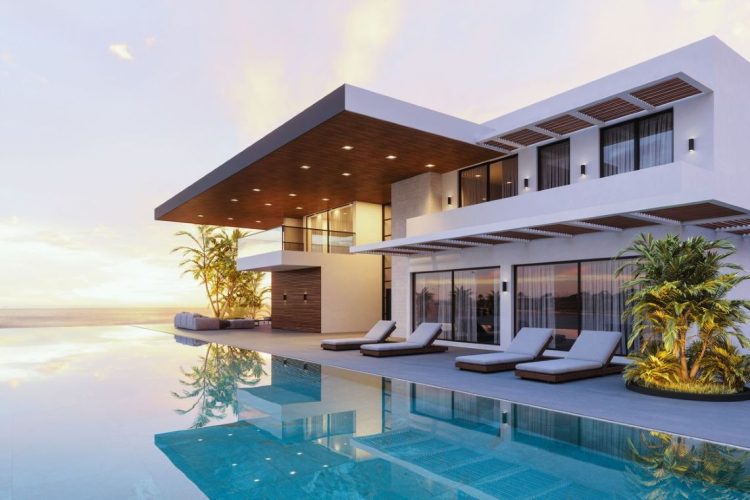The market for luxury housing has changed over the past few years. A million dollars today does not afford the same properties or retain the same value as it did nearly a decade ago.
But in the U.S., the luxury threshold varies by region. A recent study by Realtor.com®—their monthly Housing Market Luxury Report for September—found that buyers can find significantly more space for the same $1 million to $2 million price range in cities like Atlanta, Denver and Houston than other metropolitans. Luxury properties in these cities usually have more than twice the square footage available than in coastal markets.
The report uses data from Realtor.com listings as recent as September, using active inventory of single-family residences, condos, townhouses, row houses and co-ops. All of the calculations use listing price to determine the value of the home, not the final sale price.
Realtor.com defines the luxury threshold as the 90th percentile of listing prices, or the top 10% of all listings. They also found that the national benchmark for luxury decreased by 0.5% for September, dropping to $1.24 million and had a year-over-year decline of 2.4%. Previously, the threshold was $1.25 million for August and thus marks the fourth consecutive month of modest softening, according to the report.
High-end luxury—or listings within the 95th percentile or top 5%—experienced a more significant drop by falling 1.2% from last month, reaching a threshold of $1.95 million. The ultra luxury threshold—listings within the 99th percentile or top 1%—had the lowest decline of only 0.2% on a monthly basis.
Yet, the ultra luxury threshold had the greatest change year-over-year with a 5.7% decrease; the high-end luxury threshold dropped by only 2.3% from last year.
Danielle Hale, chief economist at Realtor.com, stated that, “We’re seeing a healthy rebalancing in the luxury home market after years of volatility. The modest softening in luxury prices points to a market where buyers and sellers are adjusting expectations in line with broader economic conditions. In many cases, demand remains strong for well-priced homes, especially those that deliver distinctive space, quality or location.”
Although all luxury thresholds saw slight changes in the past month, million-dollar listings continue to account for 13% of all listings within the U.S.
Market comparisons
Luxury listings typically spend more time on the market than their lower-priced counterparts, and each type of luxury listing saw increases in the median days they spend on the market for September.
Generally, median-priced homes spent about 62 days on the market for September, a two-day increase from last month and an increase by a week from last year. But luxury listings in the top 10% spend roughly 20 more days than median-priced homes on the market, according to the report.
The top 10% luxury listings spent a median of 79 days on the market in September, one day more than August’s estimates. High-end luxury listings spent about 88 days on the market, up two days from last month. Ultra luxury listings spent the most time on the market at 103 days, a one-day increase from August.
Each of the luxury listings spent more time on the market in September than one year ago. Regular luxury listings sat on the market five more days from 2024. High-end and ultra luxury listings’ market time increased by three days and one day, respectively.
As for market comparisons, there is little change in the rankings for the cities with the most expensive luxury listings, according to the report.
California continues to have multiple cities in the leaderboard for the top luxury housing market. The five areas where the listing price for luxury housing is the greatest are:
- Santa Barbara, California ($8.95 million)
- Heber, Utah ($6.5 million)
- Key West-Key Largo, Florida ($4.6 million)
- Bridgeport-Stamford-Danbury, Connecticut ($4.26 million)
- Los Angeles-Long Beach-Anaheim, California ($4 million)
Santa Barbara is a new edition to the rankings and claims the top spot with the most expensive threshold for luxury listings. Previously, Rifle, Colorado, was ranked first for the top 10 metros but was dropped from this month’s rankings. The report states that it no longer met the 500 million-dollar listings minimum required for the analysis.
The only other notable change was the switch for Bridgeport and Los Angeles, which switched spots for fourth and fifth place. Although Los Angeles is ranked fifth, it has the most million-dollar listings of the top 10 with 10,319 listings in September. The other top markets are nowhere near this amount, ranging from 500 to around 1,700 million-dollar listings.
According to the report, “the median square footage for a home listed between $1 million and $2 million nationally was just under 3,000 square feet in September.” But the report notes that what $1 million can buy varies dramatically by zipcode.
Atlanta, Georgia, offered the most square footage for a $1 million to $2 million budget at around 4,530 square feet. Luxury listings typically start around $927,000 in Atlanta, and it contains nearly 1,800 listings within the budget.
Atlanta is followed by Denver, Colorado (4,272 square feet); Minneapolis, Minnesota (4,162 square feet); Houston, Texas (4,112 square feet); and Dallas (4,072 square feet). Denver is the only metro in the top five to have luxury listings start above $1 million, typically around $1.3 million.
Metros with the least square footage for the same budget mostly consist of California cities, but ranking in first place is Honolulu, Hawaii, at 1,651 square feet. Following the Hawaiian capital are California areas, including San Jose, San Francisco and Los Angeles. In fifth place for the least square footage offered is the New York and New Jersey area, likely due to the limited space available in these states.
“Luxury buyers are increasingly seeking value—and that doesn’t always mean a lower price tag, but rather more home for the money. In markets like Honolulu or the Bay Area, buyers are paying for proximity, views and prestige—not square footage,” Realtor.com’s Senior Economist Anthony Smith commented.
“By contrast, in inland metros across the South and Midwest, high-end buyers can often find larger, newer homes with land and amenities that would cost two or three times as much in more supply-constrained coastal metros.”
For the full report, click here.











